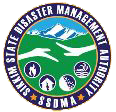-
Citizen Corner
-
White Paper on the high intensity earthquake of 18th Sept 2011
-
Sikkim State Disaster Management Plan 2022
-
Seismic Vulnerability study of the various lifeline building (schools and hospitals) in Gangtok town, based on Rapid Visual Screening
-
PMs 10 point agenda on DRR
-
Sendai Framework for DRR
-
Detailed Project Report Mitigation of Mangan Landslide at North District Headquarters Mangan, North Sikkim - India
-
Declaration of state Disaster

-
Official Bank account for receiving the CSR fund for Relief Rehabilitation and Reconstruction of Flash Flood of Sikkim 2023
-
14 Digit Form For All Non Regular Employee
-
NDMA Guidelines on the Incident Response System (IRS)
-
Sikkim Post Disaster Needs Assessments 2023
-
Notification
-
SEC
-
SESC
-
SDMA
-
DDMA
-
DM Act, Govt. of India
-
DM Act, Govt. of Sikkim
-
DM Policies
-
DM Rules
-
SDRF and NDRF Norms 2022-2026
-
News And Events
-
Covid-19 Notification

-
Self Attestation

-
National Policy on Disaster Management-2009

-
National Disaster Management Plan, 2019

-
NDMA Guidelines

-
Useful Links
-
National Disaster Management Authority
-
National Institute of Disaster Management
-
United Nations Development Programme, India
-
Ministry of Home Affairs
-
Indian Meteorological Department
-
India Disaster Knowledge Network
-
South Asia Disaster Knowledge Network
-
Alerting Humanitarians to Emergencies
 Weather Update
Weather Update
Avalanche
Sikkim receives heavy snowfall in the higher altitude regions, all throughout the year, especially during the winter months from January to March. The snow line ranges from 20,000 feet in the north to 16,000 feet in the south and the region has reported frequent avalanche incidents. Most of the times the victims have been army personals patrolling the high posts, mountain climbers and tourists. Many of these regions are remote and lack proper communication channels which further aggravate the situation. Owing to growing tourism and its benefits on the socio economic condition of the mountain regions and the increasing number of fatalities to army personals securing the borders, it has become very crucial to proactively manage disasters due to avalanche, taking an approach of avoidance instead of a relief centric approach.




